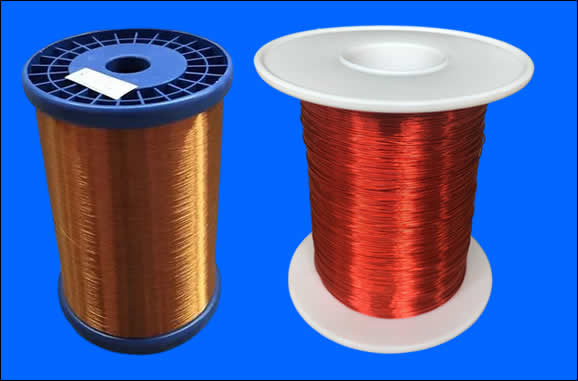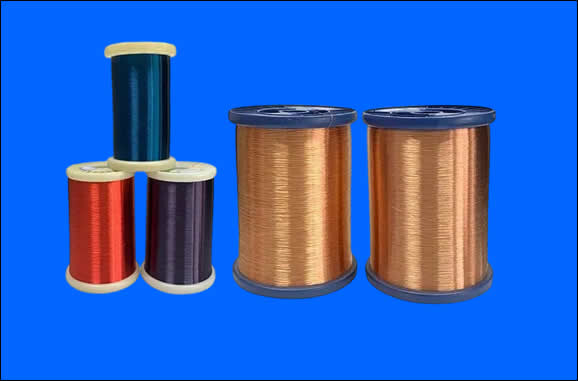Welcome to Our Website
Enameled copper wire is a widely used electrical conductor known for its excellent electrical and thermal conductivity, corrosion resistance, and mechanical strength. It finds extensive application in industries ranging from electronics and telecommunications to automotive and aerospace.

Enamelled copper wire
Type: insulated, insulated
Packing: rolls
Thermal class: 130/155/180/200/220
Classification and Specifications:
Enameled copper wire is classified based on its thermal class, insulation type, and application requirements. The thermal class indicates the maximum temperature at which the wire can continuously operate without compromising its performance. The most common thermal classes for enameled copper wire are Class 130°C, Class 155°C, Class 180°C, and Class 200°C.
The insulation types can be classified as class based on their ability to withstand different temperatures. Each class has specific thermal properties and breakdown voltage levels.

Chemical Composition:
Enameled copper wire is typically made by coating a copper conductor with a layer of insulation material. The conductor is usually composed of high-purity copper (99.9% or higher), which ensures excellent electrical conductivity. The insulation material can be composed of various types of enamel, including polyurethane (PU), polyester (PEI), polyamide-imide (PAI), polyimide (PI), or polyvinyl formal (PVF).
Mechanical Properties:
The mechanical properties of enameled copper wire are crucial for its performance and durability. The wire should possess sufficient tensile strength and elongation to withstand the stress and strain during handling, installation, and operation.
Tensile Strength and Elongation:
The tensile strength of enameled copper wire refers to its ability to withstand pulling forces without breaking. It is typically measured in megapascals (MPa) or pounds per square inch (psi). The tensile strength can vary depending on the wire diameter, insulation type, and manufacturer. Generally, enameled copper wire has a tensile strength ranging from 200 MPa to 400 MPa.
Elongation is another important mechanical property that indicates the wire's ability to stretch without permanent deformation. It is expressed as a percentage and represents the wire's flexibility. Enameled copper wire typically exhibits elongation values ranging from 15% to 30%.
Tensile Mechanical Properties:
In addition to tensile strength and elongation, other tensile mechanical properties such as modulus of elasticity and bending modulus play a crucial role in determining the wire's behavior under stress and strain. These properties determine the wire's resistance to bending, twisting, and deformation.
Roll Size, Range of Weights, and Wire Diameters:
Enameled copper wire is commonly available in the form of spools or coils. The roll size and weight range can vary based on the manufacturer and customer requirements. The wire diameters typically range from 0.02 mm (AWG 56) to 4.5 mm (AWG 6), with smaller diameters commonly used for intricate applications and larger diameters for heavy-duty applications.
Anti-Magnetic Properties:
Certain applications, such as transformer windings, require enameled copper wire with low magnetic properties. Magnetic properties are influenced by the insulation material used. Polyurethane enamel is known for its low magnetic properties, making it suitable for applications that require minimal magnetic interference.
Uses of Enameled Copper Wire:
Enameled copper wire is widely used in various industries due to its excellent electrical conductivity, thermal stability, and mechanical strength. Some common applications include:
Electric motors and transformers: Enameled copper wire is used in the windings of electric motors and transformers due to its high electrical conductivity, thermal resistance, and mechanical durability.
Electronics and telecommunications: It is used in the manufacturing of printed circuit boards (PCBs), inductors, solenoids, relays, speakers, and other electronic components.
Automotive industry: Enameled copper wire is used in ignition systems, starters, alternators, and various electrical components within vehicles.
Aerospace and aviation: It finds applications in aircraft electrical systems, including avionics, sensors, and actuators.
Household appliances: Enameled copper wire is used in the manufacturing of refrigerators, air conditioners, washing machines, and other household appliances.
What is enameled copper flat wire?
Enameled copper flat wire, also known as magnet wire or winding wire, is a type of copper wire that is coated with a thin layer of insulation enamel. The enamel insulation provides electrical insulation and protects the copper wire from corrosion, abrasion, and short circuits.
The wire itself is typically flat in shape, as opposed to round wire, and is used in a wide range of applications where a compact and efficient electrical conductor is required. The flat shape allows for better utilization of space in certain applications, such as transformers, inductors, motors, and other electromagnetic devices.
The enamel insulation used on the wire can be made from various materials, including polyester, polyurethane, polyimide, or a combination of these materials. The choice of insulation depends on the specific requirements of the application, such as temperature rating, electrical properties, and environmental conditions.
Enameled copper flat wire is available in different sizes and insulation thicknesses, allowing for customization based on the desired electrical properties and space constraints. It is widely used in industries such as electronics, automotive, telecommunications, power generation, and more, where reliable and efficient electrical connections are crucial.